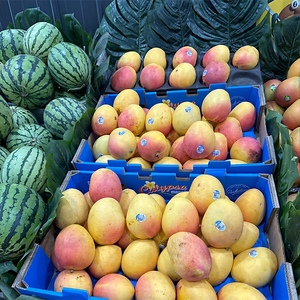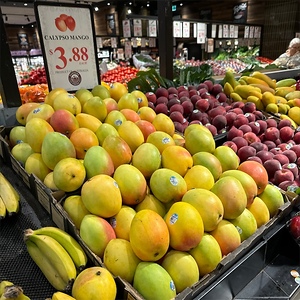


Calypso® Mangoes
Estimated Inventory, lb : 0
Description/Taste
Calypso® mangoes are generally a medium to large varietal, averaging 10 to 11 centimeters in length and 8 to 9 centimeters in diameter. They have a uniform, broad, elliptic, and ovate shape with blunt, curved ends and weigh around 457 grams. The fruit’s skin is thin, taut, leathery, and tough, ripening from green to yellow-orange hues with a bright pink-red blush. The surface is also covered in prominent lenticels and light brown freckles. These freckles develop from the variety’s natural sugar content and are an indication of the fruit’s sweetness. Underneath the surface, the golden yellow flesh is firm, smooth, aqueous, tender, and succulent. The flesh also encases a small seed tightly adhered to the center. Calypso® mangoes are known for their high flesh-to-seed ratio and are fibreless, creating a silky consistency. Select Calypso® mangoes that are absent of any green coloring and should have a slight give when gently squeezed. Calypso® mangoes are edible at multiple stages of maturity and have a sweet, tropical, fruity, and floral taste.
Seasons/Availability
Calypso® mangoes are available in the spring through summer, with a peak season in the summer. The variety is grown in three main regions within Australia, beginning with the Northern Territory from September through December. Queensland produces the fruits from December through February, followed by Western Australia, which has a brief season in November and again in February.
Current Facts
Calypso® mangoes, botanically classified as Mangifera indica, are an Australian variety belonging to the Anacardiaceae family. The hybrid cultivar is a mid-to-late-season mango primarily grown in Australia and exported worldwide as a commercial fruit. Calypso® mangoes are monoembryonic, meaning their seeds do not produce clones and must be grafted for commercial propagation. The variety is favored for its firm flesh, allowing it to be used in many different culinary preparations, and its firmer nature allows it to be shipped long distances without damage. Calypso® mangoes are also known as B74, their true varietal name, and Calypso® is a brand name given to the variety for commercial sale. Since their release to markets in the late 20th century, Calypso® mangoes have increased in popularity as a sweet, tropical fruit, and the variety is expanding in availability through export to markets worldwide. In Australia, Calypso® mangoes are widely available when in season and are primarily consumed fresh. They are also incorporated into various sweet or savory cooked dishes.
Nutritional Value
Calypso® mangoes have not been extensively studied for their nutritional properties. Some sources say the variety is a source of potassium to balance fluid levels within the body, vitamin E to guard the cells against the damage caused by free radicals, fiber to regulate the digestive tract, and vitamin C to strengthen the immune system. Mangoes also provide copper to build connective tissues, iron to develop the protein hemoglobin for oxygen transport through the bloodstream, magnesium to control nerve functions, folate to produce genetic material such as DNA, and other nutrients, including beta-carotene and vitamin B6.
Applications
Calypso® mangoes have a sweet taste suited for fresh and cooked preparations. The variety has noticeably firmer flesh than other cultivars, allowing it to be used in dishes where it can hold its shape. Calypso® mangoes can be sliced and tossed into salads, cut and served on fruit platters, or diced and added to slaws and salsa. The fruits can also be sliced into large halves, often nicknamed cheeks, and are eaten out of hand, discarding the skin and seed. Calypso® mangoes can be added as a fresh topping over seafood dishes, tacos, and rice dishes, or they can be served over burrata as an appetizer. The fruits can also be blended into smoothies, juices, cocktails, and mocktails or pureed and frozen into ice cream, sorbet, and popsicles. In addition to fresh preparations, Calypso® mangoes are incorporated into noodle dishes, cooked into sauces and glazes for roasted meats, sliced into large pieces and grilled, or sauteed as a side dish. They are also simmered into jams, jellies, syrups, chutney, and pastes for cheese plates. Try adding Calypso® mangoes into desserts such as tarts, cakes, galettes, and jellies. The fruits can also be brûléed and served with fresh cream as a dessert. Beyond raw uses, Calypso® mangoes can be dried for extended use and made into chewy strips of fruit leather. Calypso® mangoes pair well with fruits such as strawberries, raspberries, blueberries, kiwis, bananas, and grapes, herbs including cilantro, mint, basil, and parsley, and seafood such as shrimp, scallops, fish, and crab. Whole, unwashed Calypso® mangoes should be kept at room temperature to ripen and can take anywhere from 1 to 10 days to mature, depending on their degree of ripeness when purchased. Once ripe, whole mangoes can be kept in the refrigerator for a few days, but they should be immediately consumed for the best quality and flavor.
Ethnic/Cultural Info
Calypso® mangoes acquired their brand name from a public contest in 2002. Prior to this competition, the variety was known by its original name, B74 mangoes. The Queensland Department of Primary Industries and Fisheries, or QDPIF, created the contest to engage consumers and create a name that would attract attention in commercial markets. Calypso® was chosen as the brand name and is presently used worldwide to promote the fruits. In 2020, Calypso® mangoes also received unique publicity through a school project created by Jessica Collins, the daughter of mango growers in Dimbulah, Queensland, Australia. Collins sourced over 1,400 Calypso® mango seeds from her family’s farm, dried the seeds, and sewed them into a dress for her design and technology class. The dress symbolized the amount of food waste produced on farms each year, and Collins sought to raise awareness to help growers think outside the box and reuse or repurpose items typically seen as waste.
Geography/History
Calypso® mangoes are native to Australia and were developed in the 20th century. In Queensland, Australia, mango growers Jay and John Dorrian noticed that the bacterial disease black spot was affecting their mango orchards. They decided to partner with Dr. Anthony Whiley from the Horticultural Institute of the Queensland Department of Primary Industries and Fisheries to create new varieties with improved disease resistance. After several trials and experiments, a hybrid was created from breeding Sensation mangoes, an Australian variety, with Kensington Pride mangoes, a cultivar from Florida. It took over twenty years of development and evaluation before the new variety was selected for commercial production under the name B74 mangoes. B74 mangoes were released in 1999 and became a favored commercial cultivar across Australia. In 2002, B74 mangoes were given the brand name Calypso® and were awarded a patent in 2007 under US Plant Patent 17,770 P3. Today, Calypso® mangoes are cultivated in tropical regions of Australia in the Northern Territory, Queensland, and Western Australia. The variety is sold domestically throughout Australia and is exported worldwide as a specialty product, especially to New Zealand, parts of Southeast Asia, China, Korea, the Middle East, the United States, and Canada.









